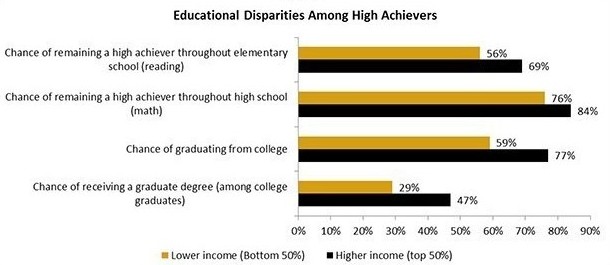While conventional wisdom may hold that academically gifted students can take care of themselves in school, a new report co-authored by UConn professor of education Jonathan Plucker reveals a starkly different story.
High-achieving students from low-income households are lagging far behind their wealthier peers in schools across the United States; and this situation has created an expanding “Excellence Gap,” according to the report, that is robbing the country of an abundance of talent and knowledge, undermining low-income students’ chances for social mobility, and impacting the nation’s future economic prosperity.

“The vast majority of our most talented students come from upper-income, economically secure circumstances,” the report states. “Economically vulnerable students, recently estimated to be roughly half of our public school population, rarely achieve academic excellence. Worse, after they are identified as high ability, they often fail to achieve at high levels, or even backslide as they progress through school.”
The report, titled “Equal Talents, Unequal Opportunities: A Report Card on State Support for Academically Talented Low-Income Students,” was funded by the Jack Kent Cooke Foundation, a national non-profit organization dedicated to advancing the education of exceptionally promising students who have financial need. Jennifer Giancola, the Cooke Foundation’s director of research, served as a co-author. UConn seniors Grace Healey and Daniel Arndt, both currently studying teaching, and Chen Wang, a graduate student in UConn’s Cognition, Instruction, and Learning Technology program, also worked on the project.
Plucker, a Raymond Neag Endowed Professor of Education at UConn, is a nationally recognized expert on education policy and talent development, and has done extensive research on programs for the talented and gifted.
“We started out looking to see how much attention state policymakers are paying to low-income, high-ability students,” says Plucker, who is affiliated with UConn’s Neag School of Education. “What we found was that there is very little attention being paid. It just doesn’t seem to be on state policymakers’ radar screens.”
We must reverse the downward trajectory of these students’ educational achievement not only to improve their lives but also to strengthen our nation. — Harold Levy, Cooke Foundation
The researchers gathered data from every state and the District of Columbia, in an attempt to learn what states are doing to address the needs of advanced students; what practices are in place; and which interventions appear to have the greatest impact. The team then scored the results for 18 indicators, representing nine state-level polices and nine specific student outcomes.
The team found that overall, the data reflects a public education system that does not appear focused on high-performing students and is unaware of the inherent discrepancies that exist between high-achieving students from families at different income-levels. Lacking access to enriched academic opportunities, individualized lesson plans, and the kind of counseling provided to wealthier students, high-achieving, economically vulnerable children are becoming what one researcher has called “a persistent talent underclass.”
“It is a story of demography predetermining destiny,” the report says.
Findings
The report found:
- In most states, attention to advanced learning is incomplete and seemingly haphazard. Patchwork services appear to primarily benefit students in wealthier districts.
- Individual states’ performance appears to be influenced more by the wealth and ethnicity of their students than any singular policy initiative to help high-performing, economically vulnerable students.
- While some states had impressive outcomes, no state had impressive outcomes for economically disadvantaged students. Massachusetts, for example, leads the nation with 18 percent of its students scoring advanced on the National Assessment of Educational Progress (NAEP) test for Grade 8 math assessment. But only 6 percent of students qualifying for free or reduced-price lunch scored advanced, while 26 percent of non-qualifying students did. The report called the 20 percent gap “staggering.” Similar disparities were found in numerous other states.
The goal of the project was to bring the discrepancies in support for high-ability students to the forefront and to encourage state policymakers to begin taking steps to rectify the situation.
The number of high-achieving children impacted by the lapse in support is alarming, advocates say. Current statistics show that low-income students account for 51 percent of all students in the United States. About 3.4 million K-12 children residing in households with incomes below the national median rank in the top 25 percent academically. More than one million K-12 children who qualify for free or reduced-price lunch rank in the top quartile academically; in other words, there are about 80,000 very smart, very poor students per grade.

“Our education policies ignore some of our brightest students who happen to come from low-income backgrounds,” says Harold Levy, the Cooke Foundation’s executive director. “They need our help. They deserve our help. The potential that is lost year after year due to benign neglect of our brightest students damages our nation’s global competitiveness. America must do better.”
Some states have already started moving in the right direction by appointing high-level state officials dedicated to improving programs for the talented and gifted, Plucker says. But much more needs to be done.
Plucker acknowledges that local school officials have limited resources and the driving concern of late has been reducing the academic achievement gap – which refers to the disparity in academic performance between groups of students, particularly the gap in performance between African-American and Hispanic students and their non-Hispanic white peers, as well as performance gaps among students from low-income families and their wealthier peers. But Plucker doesn’t see addressing the achievement gap and the excellence gap as an ‘either/or’ issue.
“We’ve looked at a lot of other countries who don’t see it as an either/or issue,” Plucker says. “The excellence gap is about equity AND excellence. So why not do what other countries have done and try to do both? I think there are things we can do now, especially with all the new technology available, to individualize the progress of every student through school. Twenty years from now, we’re going to look back and say, ‘Why weren’t we doing this sooner?’”
Recommendations
The report makes four specific recommendations, which Plucker says are easy to implement and cost effective.
- Make high-performing students more visible by requiring local school districts to collect data on gifted and talented students, their income levels, and performance over time.
- Remove barriers that prevent high-performing students from moving through coursework at their own pace. Require school districts to allow early entrance to kindergarten, acceleration between grades, dual enrollment in middle and high school (with appropriate credits given), and early graduation from high school.
- Ensure that all high-performing students have access to advanced educational services by mandating services for talented and gifted pupils, expanding teacher training, and increasing classroom opportunities.
- Hold local school districts accountable for the performance of all high-ability students by inserting accountability measures for gifted student performance in state public education systems.
“We must reverse the downward trajectory of these students’ educational achievement not only to improve their lives but also to strengthen our nation by unleashing the potential of literally millions of young people who could be making great contributions to our communities and country,” the Cooke Foundation’s Levy says. “Sadly, even though our society has a stake in ensuring that high-achieving, low-income students complete their education and compete for higher-paying jobs, our nation largely ignores these students, as they are absent from policy discussions. This must change.”
The full report Equal Talents, Unequal Opportunities: A Report Card on State Support for Academically Talented Low-Income Students can be found at excellencegap.org.



